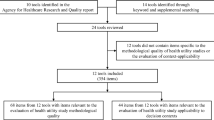Abstract
Background
Evaluating the relevance of published health utilities to the context of a cost-utility analysis (CUA) remains an essential, yet often overlooked, task.
Objective
The objective of this study was to provide guidance on this process through the development of the Health utility Application Tool (HAT).
Methods
We conducted semi-structured telephone interviews with Canadian stakeholders from reimbursement bodies, academia, and the pharmaceutical industry to identify current practices and perspectives of the application of the health utility literature to CUAs. An online survey with international members of the general health economics and outcomes research community was also conducted to gather opinions on key concepts.
Results
Based on the themes emerging from the interviews and online questionnaire, the HAT includes questions prompting investigators to consider the following constructs: similarity of the clinical condition in the health utility study and the CUA; similarity of health utility study participant demographics and the demographics of the CUA’s target population; similarity of the health state descriptions in the health utility study and the CUA; and the method of assigning utility weights. Considerations of transparency prompted additional items, including: means by which the health utility study was identified; type of respondents; study design; and measure used to collect health utility estimates.
Conclusion
The HAT is intended to guide the evaluation of the applicability of published health utilities for a CUA, thus promoting transparency and accountability in the selection of model inputs.


Similar content being viewed by others
References
National Institute for Health and Care Excellence. Developing NICE guidelines: the manual. NICE; 2014.
Australian Government. Guidelines for preparing a submission to the Pharmaceutical Benefits Advisory Committee (Version 5.0). Sydney, NSW: Department of Health; 2016.
Canadian Agency for Drugs and Technologies in Health. In: Guidelines for the economic evaluation of health technologies: Canada. 4th ed. Ottawa: CADTH; 2017. https://www.cadth.ca/dv/guidelines-economic-evaluation-health-technologies-canada-4th-edition.
Xie F, Zoratti M, Chan K, Husereau D, Krahn M, Levine O, et al. Toward a centralized, systematic approach to the identification, appraisal, and use of health state utility values for reimbursement decision making: introducing the Health Utility Book (HUB). Med Decis Mak. 2019;39(4):370–8. https://doi.org/10.1177/0272989x19837969.
Ara R, Peasgood T, Mukuria C, Chevrou-Severac H, Rowen D, Azzabi-Zouraq I, et al. Sourcing and using appropriate health state utility values in economic models in health care. Pharmacoeconomics. 2017;35(1):7–9. https://doi.org/10.1007/s40273-017-0543-z.
Papaioannou D, Brazier J, Paisley S. Systematic searching and selection of health state utility values from the literature. Value Health. 2013;16(4):686–95. https://doi.org/10.1016/j.jval.2013.02.017.
Zoratti MJ, Pickard AS, Stalmeier PFM, Ollendorf D, Lloyd A, Chan KKW, Husereau D, Brazier JE, Krahn M, Levine M, Thabane L, Xie F. Evaluating the conduct and application of health utility studies: a review of critical appraisal tools and reporting checklists. Eur J Health Econ. https://doi.org/10.1007/s10198-021-01286-0.
Saunders B, Sim J, Kingstone T, Baker S, Waterfield J, Bartlam B, et al. Saturation in qualitative research: exploring its conceptualization and operationalization. Qual Quant. 2018;52(4):1893–907. https://doi.org/10.1007/s11135-017-0574-8.
Burmeister E, Aitken LM. Sample size: how many is enough? Aust Crit Care. 2012;25(4):271–4. https://doi.org/10.1016/j.aucc.2012.07.002.
Cohen D, Crabtree B. Qualitative Research Guidelines Project. 2006. http://www.qualres.org/HomeSemi-3629.html. Accessed 10 Jul 2017.
Guest G, MacQueen K, Namey EE. Applied thematic analysis. Thousand Oaks: Sage; 2011.
Roudijk B, Donders ART, Stalmeier PFM. Cultural values: can they explain differences in health utilities between countries? Med Decis Making. 2019;39(5):605–16. https://doi.org/10.1177/0272989x19841587.
Acknowledgements
The Health Utility Book (HUB) Working Group members: Feng Xie, Michael J. Zoratti, Kelvin K. W. Chan, Don Husereau, Murray Krahn, Holger Schunemann, and Gordon Guyatt. The authors thank everyone who contributed to the development of this tool through either a telephone interview or a response to our online survey. While all participants had the option of remaining anonymous, the following have agreed to be acknowledged: Kabirraaj Toor, Whitney Longstaff, Colin Vicente, Lauren Cipriano, Donna Lawrence, Brittany Humphries, Wendy Ungar, A. Simon Pickard, Ahmed M. Y. Osman, Alex Li, Bernhard Michalowsky, Bin Wu, Boxiong Tang, Chang, Chao Wang, Charlene Niu, Chen, Chris Cameron, Ena Pery Niño de Guzman, Ernest Law, Gian Paolo Morgano, Gina, Graeme Ball, Haijing Guan, Hansen, Henry J. Conter, Hongchao Li, James W. Shaw, Jeffrey Johnson, Jie You, Jing Wu, Juan M Cabasés, Junwei Gao, Junwen Zhou, Lei Si, Lidia García, Marisa da Silva Santos, Matthijs Versteegh, Melina Leng, Nathan McClure, Nigar Sekercioglu, Olga Veljanoski, Paula Lorgelly, Peijing Yan, Rachel Harrington, Rosalie Viney, Shan Jiang, Sheng Wang, Sumeet Singh, Tania Conte, Tara Lavelle, Ting Zhou, Valentina Rupel, Weijin Fang, Wenying He, Xiangli Cui, Xiaoping, Xue Li, Yangwei, Yangyi, Zhiyuan Chen, and Huijun Zhou.
Author information
Authors and Affiliations
Consortia
Corresponding author
Ethics declarations
Funding
No funding was received for this study.
Conflict of interest
Michael J. Zoratti, Kelvin K. W. Chan, Mitchell Levine, Lehana Thabane, Murray Krahn, and Feng Xie declare no financial or other relationships that may lead to a real or perceived conflict of interest. Don Husereau has consulted for HTA organizations and life sciences companies who may have an interest in this work.
Availability of data and material
Anonymized data may be provided upon written request to the study authors.
Code availability
Not applicable.
Author contributions
All authors conceived the study concept. MZ and FX collected and conducted an initial interpretation of the data, and drafted the initial manuscript. All authors provided critical revisions to the manuscript, and all authors approved the final version of the manuscript.
Additional information
The Health Utility Book (HUB) Working Group members are listed in the Acknowledgement section.
Supplementary Information
Below is the link to the electronic supplementary material.
Rights and permissions
About this article
Cite this article
Zoratti, M.J., Chan, K.K.W., Husereau, D. et al. Towards Transparency in the Selection of Published Health Utility Inputs in Cost-Utility Analyses: The Health Utility Application Tool (HAT). PharmacoEconomics 39, 1075–1084 (2021). https://doi.org/10.1007/s40273-021-01039-0
Accepted:
Published:
Issue Date:
DOI: https://doi.org/10.1007/s40273-021-01039-0




